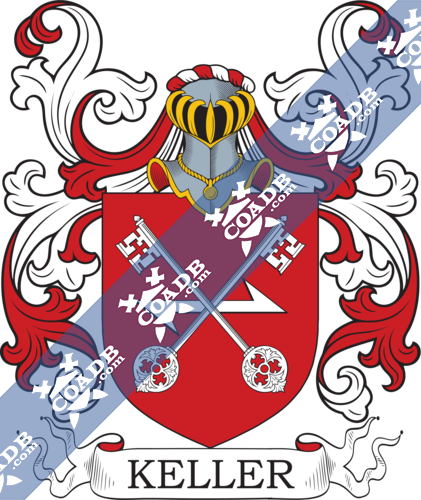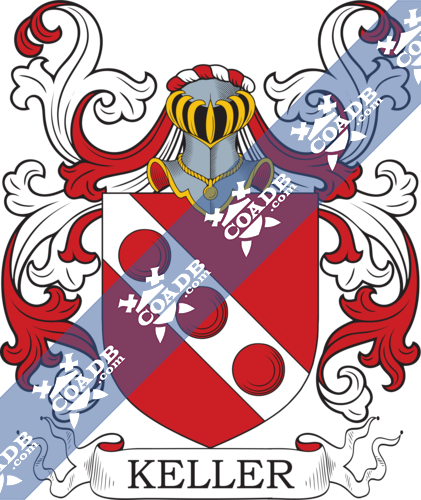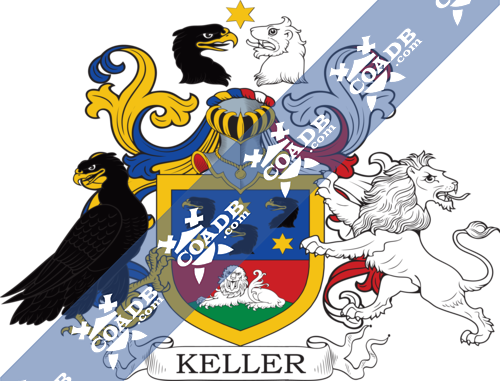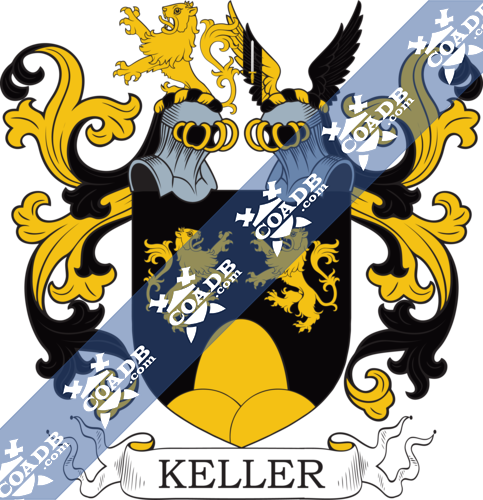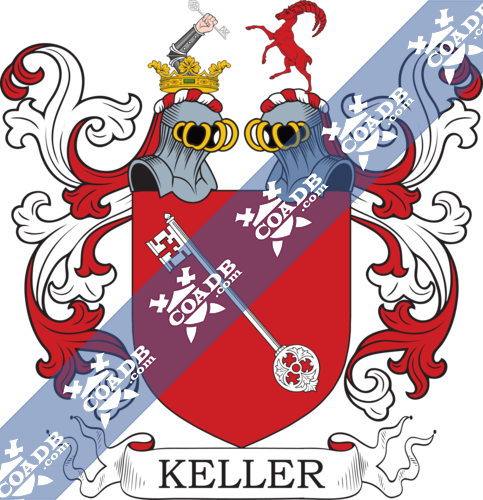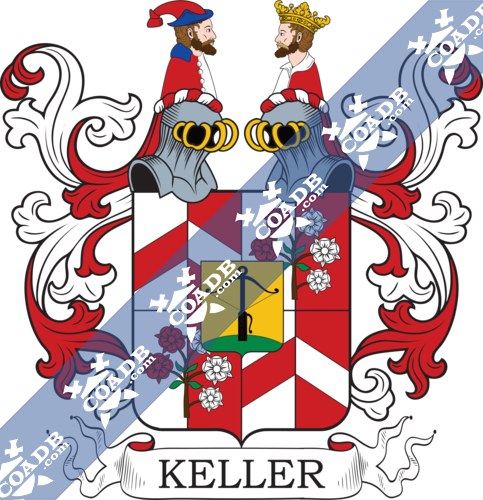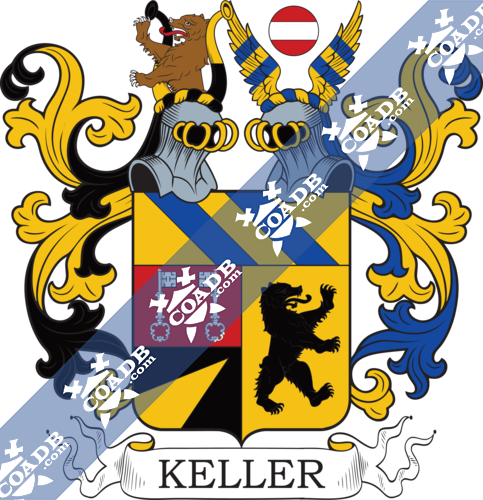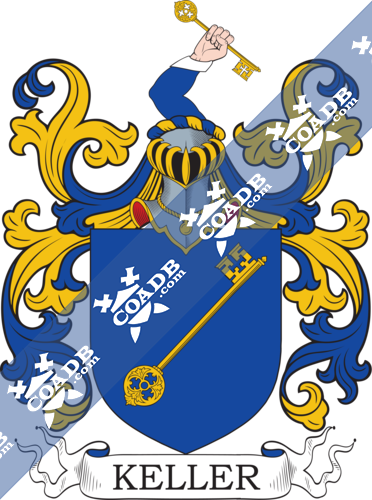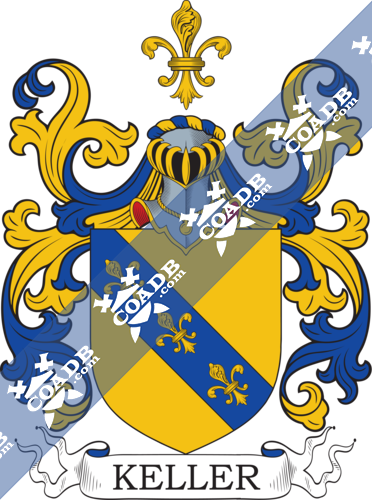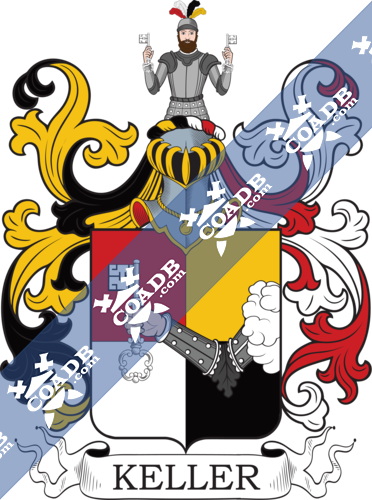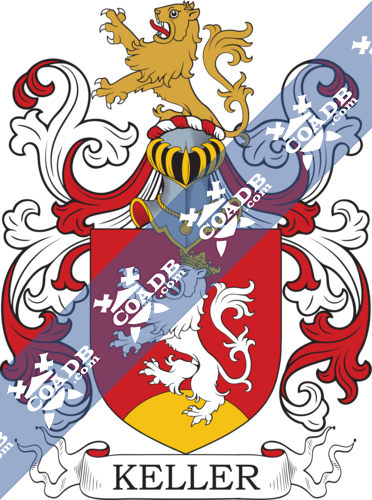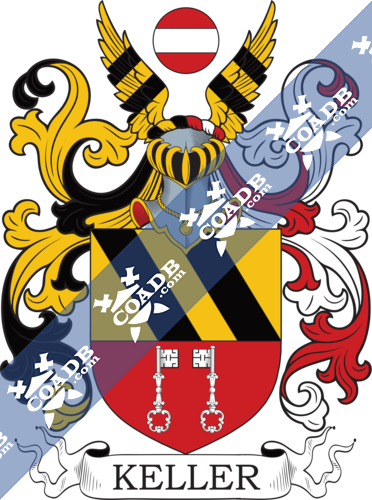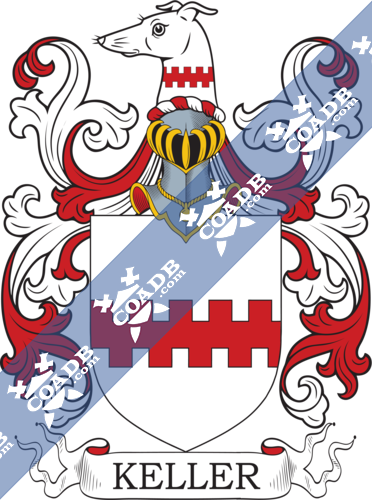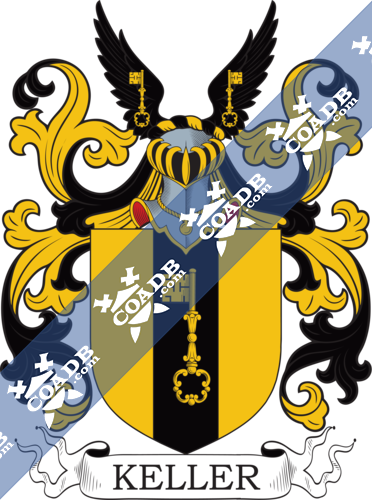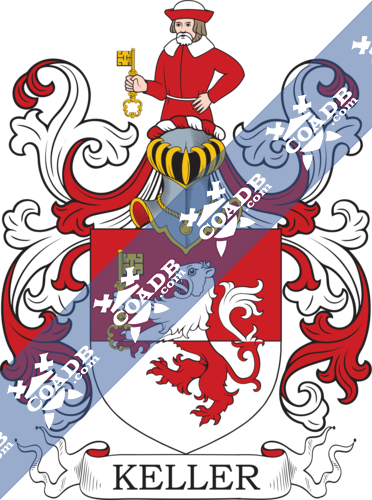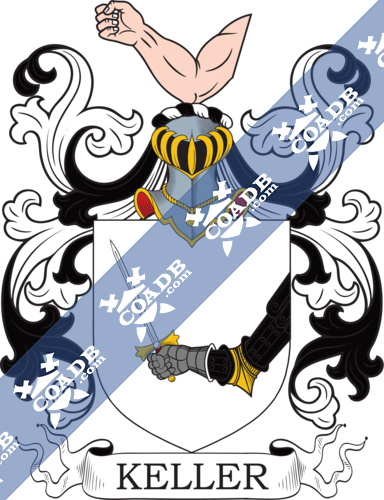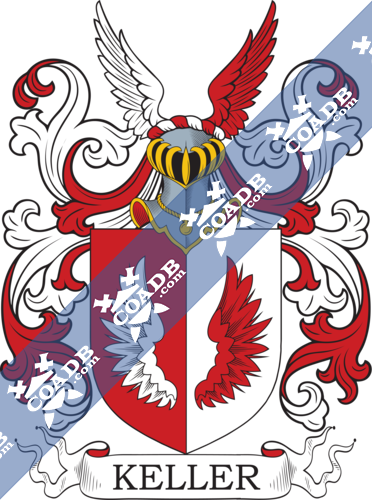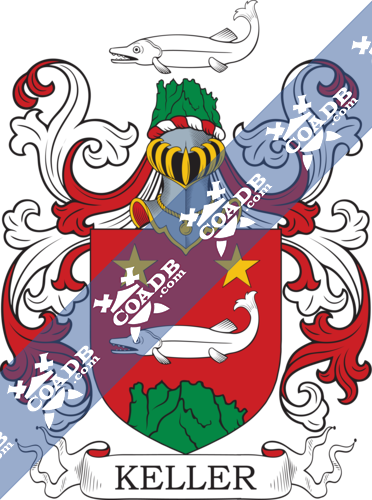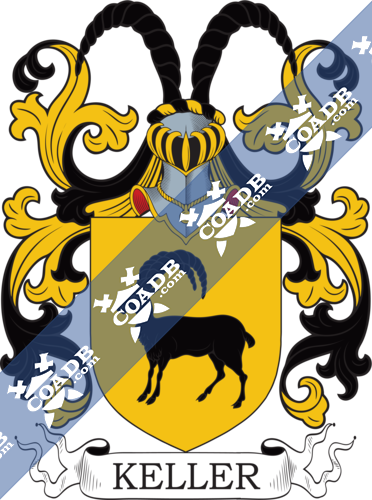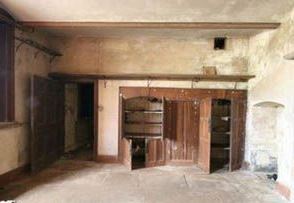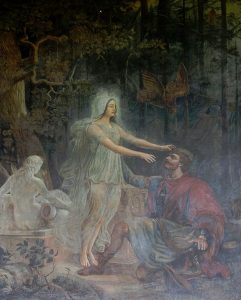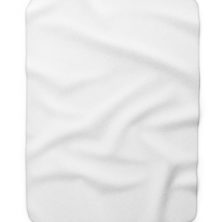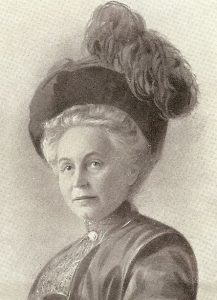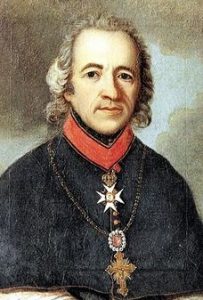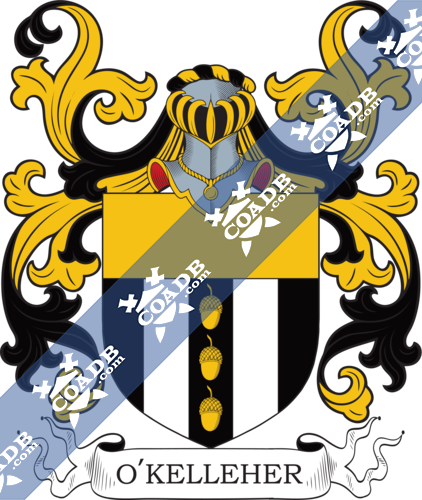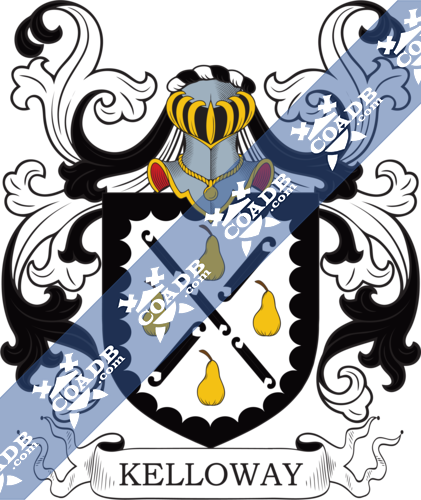Keller Family Crest, Coat of Arms and Name History

Keller Coat of Arms Gallery
Don’t know which Coat of Arms is yours?
We can do a genealogical research. Find out the exact history of your family!
Learn MoreThe common German and central European surname Keller derives from the Middle High German word kellaere, meaning “cellarman” or “cellar master”, related to the Latin word cellarious. As such, this is a last name of occupational origin, as the name referred to a person who was the keeper of cellars, pantries, store chambers, households, or accounts, that were in places such as monasteries, castles, and fortresses throughout Europe and Christendom for a living. As valued stewards of royal households, they were sometimes elevated to ministerial rank (a cabinet position in government). Other say Keller’s were winemakers. Some sources assert this family first established itself in the duchy of Swabia, which was part of the German kingdom, the East Francian State, and the Holy Roman Empire that existed from 915 to 1313 AD.
The name was also present in the British Isles for hundreds of years. In England, it can be an occupational name for a person who made caps or cauls, deriving from the Middle English word kellere, or perhaps the name of an executioner, deriving from the Old English word cwellere. In Ireland, it can sometimes be a reduced for of Kelleher, and in Scotland, it can be a spelling variant of the surname Keillor. It may also be a Anglicized spelling of the Gaelic name O’Ceileachair , a name meaning companionable, a family that claims descent from Ceileachar, a nephew of Brian Boru (High King of Ireland from 1002 to 1014 AD, and were members of the Dalcassian clan in the territory of Tuathhuman (modern day Clare and parts of Tipperary and Limerick).
The spelling variants of this popular last name are numerous, including, but not limited to Keler, Kelleher, Kelliher, Kalaher, Keeller, Kellner, Kelaher, O’Kelleher, McKeller, MacKeller, Celler, Cellner, Celer, and Cellern.
Early bearers of this surname include Herman de Kelner who was documented in Rottweil, Wurttemberg, Germany in 1314 AD. A one John Keller was recorded in the Poll Tax of Yorkshire, England in 1379 AD. An early documented marriage involving this surname was Godrey Keller to Elizabeth Savery at Canterbury in 1686.
Early settlers and immigrants in colonial America who bore this name began to come in the early eighteenth century, and include: Conrad Keller (New York 1709), Frank Keller (New York 1710), Michael Keller (Pennsylvania 1728), and John Keller (Pennsylvania 1732). In Canada, in 1757, the following three bearers landed in Nova Scotia: Bernard, Catharina, and Magdelena Keller. In Australia, a one Godfred Keller landed in South Australia in 1848 aboard the Pauline.
Some of the most notable bearers include: 1) Helen Adams Keller (1880-1968) who was an American deaf-blind woman from Tuscumbia, Alabama who because the first of her background to earn a college degree, later becoming an author, lecturer, and political activist, 2) Charles Ernest Keller (1916-1990) who was a baseball player in the MLB, born in Maryland, who played from 1939 to 1952 for the New York Yankees and Detroit Tigers, 3) Count Fyodor Keller (1850-1904) who was a general in the Imperial Russian army who serves in the Serbian-Turkish Wars, Russo-Turkish Wars, and Russo Japanese War, 4) Bill Keller (1949) who was the executive editor of the New York Times from 2003-2001, and 5) Major General Rodney Frederick Leopold Keller (1900-1954) who was a Canadian General born in England who commanded the 3rd Infantry Division on Juno Beach during the D-Day Invasion.
The name is very popular in the following nations: Switzerland (3rd), Germany (34th), Austria (311), and the United States (277). It is also common in the small counties of Luxembourg and Liechtenstein. It is particularly common in the five following states: Pennsylvania, Montana, North Dakota, South Dakota, and Nevada. The name’s popularity around the Western world reminds one of the following quote from Alexander Solzhenitsyn: “The German is like a willow. No matter which way you bend him, he will always take root again”.
One branch of the family can be traced back nine generations to Peter Keller and his wife Magdalena, who lived in 1777, in Rastadt, Russian (in modern day Odessa, Ukraine). The Rastadt settlement was named after Rastatt, Germany, then bard of the duchy of Baden, where Peter and his ancestors descended from.
There is a legend about a Knight named Burkhart Keller von Yburg who lived in Castle Hohenbaden located near Baden in Rasttat, Germany in the 1400s AD. It is one of numerous stories involving the Black Forest in medieval times or the Middle Ages. This legend involves a famous painting called Kellerkreuz (meaning Keller’s Cross) that still stands on the castle grounds. According to the legend, Knight Burkhardt Keller was returning to his castle, walking back from a nearby village, when a nymph appeared to him, seduced him, convinced him to stay several nights and dig a large hole in the ground. In reality, she had tricked him to dig up her pagan alter, and upon this revelation, she killed him there. His younger brother found his dead body and in fit of rage he smashed and buried the altar. He then constructed a large stone cross and erected it there. Said cross still stands along the Kellerfreuz (Keller Cross) pathway. It symbolized a rejection of paganism in favor of Christianity.
The only documented Keller family motto I am aware of is “Vaillant et veillant”, which is French for “Valiant and ensuring”.
Aeberli Keller was born in Weinfelden, Thurgau, Switzerland in 1526. He married Ottilie Ziegler and had a son with her named Sebastian. Sebastian was born in the same town in 1553 and he married Margreth Sandi and had a son with her named Hans Jacob. This Hans Jakob Keller was born in Scherzingen, Thurgau in 1585. He married Adelheir Bornhauser and had a daughter with her named Ursula. She was born in Weinfelden in 1611. She married Conrad Heuberger and had a son with him named Hans Jakob.
Heinrich Kaeller or Keller was born in Fehraltorf, Zurich, Switzerland in around 1502 AD. He had a son named Anthony Kaeller who was born in Ruti, Fehraltorf in around 1519. He married Anna Meyer and had three issue with her: Andreas, Regula, and Hans Kaeller. His son Hans Kaeller or Keller was born in the same town in Zurich, Switzerland in 1550. He married Madalena Bosshart and had the following children with her: Susan, Ulrich Uli, George York, Myorg, Felix, Madalena (Hirtzel), and Magdalena.
Wilhelm Keller was born in Bavaria. He had a son named Johann Georg who was also born in Bavaria. Johann married Elisabeth Johanna Kleffel and had a son with her also named Johan George. This son Johan Georg Keller was born in Meiningen, Germany around 1800 He married Anna Barbara Krell. He went to the United States. He died in Milwaukee, Wisconsion around 1870. He had a son named Amalius Malchius Philippe who was born in 1825. He was a woodworker and cabinet by trade, like his father and grandfather before him. He married Magdalina Eva Helena in Milwaukee in 1849 and had three sons with her: George C., Charles Frederick, and Oscar. His son George C. Keller was born in 1850 and married Louise A. Pfitzer (having issue named George W., Walter O, Hertha A.F., Alice Post, and Louise) and his son Charles Frederick was born in 1852 and married Eliza Reinhold and Helena Hafenbeck (having issue with her named William, Anna G. Bauman, Carola Goldsmith, Charles, Irene, Eleanor Hulick, Harry, and Helen (Sauer).
Bastian Keller was born in Siblingen, Kanton, Switzerland in 1680. He married Elisabetha Hildebrandt and had a son with her named George. George Keller was born in Weiler, Rheinland-Pfalz, Germany in 1719. He moved to the United States in married Barbara Anna Hottel in Lancaster, Pennsylvania in 1733 and had the following issue with her: George, John, Elizabeth , Anna (Flavel), Henry, and George. His son John was born in Lancaster, Pennsylvania in 1736. He married Mary Bowman in 1761 in Virginia. They had the following children together: George, Benjamin, Jacob, Elizabeth, Daniel, Maria, John Henry, David, and Joseph. His son John Henry was born in Shenandoah, Virginia around 1775, married Eleanor Rebecca Carter, and had a son with her named Andrew Jackson. Andrew was born in Owen, Indiana in 1831. He married Nancy Coffman and had two issue with her: William Hiram and Mary Jennie. His son William Hiram Keller was born in Indiana in 1857. He married Emma Holley and had the following issue with her: Rachel, Enert N., Otis, William C., Estella May, Ada E., Francis, and Lawrence. His son Lawrence H. was born in the 1890s. He died in the 1960s, but had multiple issue include Dallas Keller, Doris (Cross), and Ruth (Altenbaumer). Dallas was born in the 1920s and passed away in the 2000s.
Blazons & Genealogy Notes
2) Soleure – De gueules à une clef d’argent le panneton en haut à dextre. English: Gules with a key argent the head of the key upwards to the dexter.
3) Soultz (Haute-Alsace) – (Gasser. Livre d’or de Soultz) – D’or à trois têtes et cols d’aigle de couleur brunâtre becquées d’or Cimier l’un des meubles de l’écu Lambrequin d’or et de gueules. English: Or threes heads and shoulders of eagles brunatre beaked or Crest: one of the charges from the shield Mantling: or and gules.
4) Prusse – Coupé au 1 d’azur à trois têtes d’aigle de sable becquées d’or languées de gueules acc de trois étoiles mal-ordonnées d’or au 2 de gueules à un lion d’argent couché sur un tertre de sinople la tête posée de front L’écu bordé d’or Casque couronné Cimier une tête d’aigle de l’écu et une tête de lion d’argent affrontées surmontées d’une étoile d’or Lambrequin à dextre d’or et d’azur à senestre d’argent et de gueules Supports à dextre une aigle regardante de sable becquée et membrée d’or languée de gueules à senestre un lion regardant d’argent Devise VAILLANT ET VEILLANT. English: Per fess 1st azure three heads of eagles sable beaked or langued gules accompanied by three etoiles disordered [1 2] or 2nd gules with a lion argent laying on the ground on a hillock vert the head placed facing forwards the shield with a bordure or Crowned with a helmet Crest: a head of an eagle of the shield and an head of a lion argent facing the viewer surmounted by an etoile or Mantling: to the dexter or and azure to the sinister argent and gules Supporters to the dexter an eagle reguardant sable beaked and legged or langued gules to the sinister a lion reguardant argent Motto: VAILLANT ET VEILLANT.
5) Prusse, Russie – (Nob. du St-Empire, 14 sept. 1737; comtes, 39 nov. 1789) – Écartelé aux 1 et 4 d’argent à une losange de gueules (Köller) aux 2 et 3 d’azur à une clé d’or en barre () Deux casques couronnés Cimiers 1° une tête et col d’aigle de sable languée de gueules becquée d’or sommée d’une couronne royale du même 2° un bras armé au naturel la main gantelée tenant une clé d’or en fasce le panneton en haut à senestre Lambrequin d’argent et de gueules. English: Quarterly 1st and 4th argent with a lozenge gules ( For Koller ) 2nd and 3rd azure with a key or bendwise sinister ( ) Crowned with two helmets Crests: 1st a head and shoulder of an eagle sable langued gules beaked or surmounted by a Royal crown sable 2nd an arm armoured proper the hand gauntletted holding a key or fesswise the head of the key upwards to the sinister Mantling: argent and gules.
6) Silésie – (Barons, 26 juillet 1765) – Parti au 1 coupé a de gueules à deux clés affrontées d’argent b de sable à une pointe d’or posée en barre mouvant du canton dextre au 2 d’or à un ours rampant et contourné de sable Au chef de l’écu d’or brochant sur le parti et ch de deux bandes d’azur Deux casques le 2 couronné Cimiers 1° l’ours issant entre deux proboscides coupées alternativement de sable et d’or Lambrequin d’or et de sable 2° une boule de gueules ch d’une fasce d’argent entre un vol aux armes du chef (sur l’aile dextre les bandes sont transformées en barres) Lambrequin d’or et d’azur. English: Per pale 1st per fess a) gules two keys affrontant [face to face] argent b) sable with a base or placed bendwise sinister coming from quarter dexter 2nd or with a bear rampant and reversed sable a chief of the shield or covering over the per pale and charged with two bendlets azure two helmets the 2nd crowned Crests: 1st the bear issuant between two proboscides per fess alternately sable and or Mantling: or and sable 2nd a ball gules charged with a fess argent between a pair of wings with the arms of chief ( over the wing dexter the bendlets are transformed in to bendlets sinister ) Mantling: or and azure.
7) Wurtemberg – D’or à un bouquetin arrêté de sable Casque couronné Cimier deux cornes de bouquetin de sable adossées. English: Or with an ibex statant sable Crowned with a helmet Crest: two horns of an ibex sable addorsed [back to back].
8) Zurich, Prusse – (Rec. de nob., 1852) – – Écartelé au 1 de sable plein au 2 d’argent à un grillage de sable de cinq pièces sur six au 3 d’argent à un pic à rhabiller penché de sable au 4 de pourpre plein. English: Quarterly 1st sable plain [uncharged] 2nd argent grillage sable of five parts over six 3rd argent with a pick-axe [for repairing?] bendwise sable 4th of purpure plain [uncharged].
9) – De gueules à la bande d’argent ch de trois boules du champ Cimier une corne de bouquetin d’or ornée le long du dos de trois boules de gueules sommées chacune d’un panache de plumes de coq de sable. English: Gules a bend argent charged with three balls of the field Crest: a horn of an ibex or decorated along the back with three balls gules surmounted by each a plume of feather of a cockerel sable.
10) Suisse – De sable à un tertre de trois coupeaux d’or celui du milieu escarpé et élevé jusqu’au coeur de l’écu ledit tertre surmonté de deux lions affrontés d’or Deux casques couronnés Cimiers 1° un lion issant d’or 2° un vol à l’antique l’aile de derrière de sable plein l’aile de devant d’or ch d’un pal de sable surch d’une épée d’argent garnie d’or. English: Sable with a hillock of three peaks or that of the of the middle steeper and elevated up to the heart of the shield the aforesaid hillock surmounted by by two lions affrontant [face to face] or Crowned with two helmets Crests: 1st a lion issuant or 2nd a pair of wings ancient the wing of the rear sable plain [uncharged] the wing to the front or charged with a palet sable surcharged with a sword argent hilt and pommell or.
11) Vienne – (Chevaliers, 12 juin 1882) – De sable à une clé d’argent posée en bande le panneton en haut à dextre acc de deux étoiles d’or le tout acc d’un tertre de trois coupeaux de sinople en pointe. English: Sable with a key argent placed bendwise the head of the key upwards to the dexter accompanied by two etoiles or all accompanied by a hillock of threes peaks vert in base.
12) Winterthür – De gueules à une clé d’argent posée en bande le panneton en haut à dextre Deux casques le 1 couronné Cimiers 1° un bras armé au naturel la main de carnation tenant une clé d’argent en bande le panneton en bas à senestre 2° un bouquetin rampant de gueules. English: Gules with a key argent placed bendwise the head of the key upwards to the dexter two helmets one crowned Crests: 1st an arm armoured proper the hand carnation holding a key argent bendwise the head of the key downwards to the sinister 2nd an ibex rampant gules.
13) Prusse – D’azur à une clé d’or posée en barre le panneton en haut à dextre Cimier un bras paré d’azur rebrassé d’argent la main de carnation tenant une clé d’or en bande le panneton en bas à dextre. English: Azure with a key or placed bendwise sinister the head of the key upwards to the dexter Crest: an arm clothed azure turned back [of cuffs etc.] argent the hand carnation holding a key or bendwise the head of the key downwardss to the dexter.
14) Baden (Argovie) – D’azur à une clé d’argent posée en bande le panneton en haut à dextre Cimier un vol d’azur chaque aile ch d’une clé d’argent en pal (les clés adossées). English: Azure with a key argent placed bendwise the head of the key upwards to the dexter Crest: a pair of wings azure each wing charged with a key argent palewise ( the keys addorsed [back to back] ).
15) Bâle – D’or à la bande d’azur ch de trois fleurs-de-lis du champ posées dans le sens de la bande Cimier une fleur-de-lis d’or posée en pal. English: Or a bend azure charged with threes fleur de lys of the field placed ins the direction of the bend Crest: a fleur de lys or placed palewise.
16) Bâle – Écartelé aux 1 et 4 parti d’argent et de gueules au chevron de l’un en l’autre aux 2 et 3 parti d’argent et de gueules à une branche de rosier brochant sur le parti fleurie de cinq pièces de l’un à l’autre deux à dextre et trois à senestre Sur le tout d’or à une arbalète de sable soutenue d’un tertre de sinople Deux casques couronnés Cimiers 1° un buste d’homme contourné habillé aux armes du 1 au rabat d’azur coiffé d’un bonnet albanais de gueules retroussé d’azur 2° un buste de femme de profil couronné d’or les cheveux tressées habillé aux armes du 2. English: Quarterly 1st and 4th per pale argent and gules a chevron counterchanged 2nd and 3rd per pale argent and gules with a branch of a rose bush covering over the per pale flowered of five pieces counterchanged two to the dexter and three to the sinister overall or with an crossbow sable standing on a hillock vert Crowned with two helmets Crests: 1st a bust of a man reversed dressed with the arms of 1 with flaps azure wearing on the head a Albanian [woollen?] hats gules turned up azure 2nd a bust of a man in profile crowned or the hair plaited [woven] dressed with the arms of 2.
17) Allemagne – Écartelé de gueules d’or d’argent et de sable à un senestrochère armé au naturel issant d’une nuée d’argent mouvant du flanc la main de carnation tenant une clé en pal Casque couronné Cimier un homme d’armes issant le casque panaché de gueules d’argent de sable et d’or tenant de chaque main une clé en pal le panneton de celle à senestre contournée entre un vol coupé à dextre de gueules sur argent à senestre d’or sur sable Lambrequin à dextre d’or et de sable à senestre d’argent et de gueules. English: Quarterly gules or argent and sable with a left arm armoured proper issuant a cloud argent coming from the flank the hand carnation holding a key palewise Crowned with a helmet Crest: a man of arms issuant the helmet plumed gules argent sable and or holding in each hand a key palewise the head of the key of that to the sinister reversed between a pair of wings per fess to the dexter gules over argent to the sinister or over sable Mantling: to the dexter or and sable to the sinister argent and gules.
18) Allemagne – D’argent au sautoir de gueules acc de quatre roses du même. English: Argent a saltire gules accompanied by four rose of the same.
19) Alsace – De gueules au lion d’argent couronné d’or soutenu d’un tertre du même Cimier le lion issant. English: Gules of lion argent crowned or standing on a hillock of the same Crest: the lion issuant.
20) Nördlingen (Bavière) – Coupé au 1 d’or à deux bandes de sable au 2 de gueules à deux clés affrontées en pals d’argent Cimier une boule de gueules ch d’une fasce d’argent entre un vol aux armes du 1 (sur l’aile dextre les bandes sont transformées en barres) Lambrequin à dextre d’or et de sable à senestre d’argent et de gueules. English: Per fess 1st or two bendlets sable 2nd gules two keys affrontant [face to face] palewise argent Crest: a ball gules charged with a fess argent between a pair of wings with the arms of 1 ( over the wing dexter the bendlets are transformed into bendlets sinister ) Mantling: to the dexter or and sable to the sinister argent and gules.
21) Prov. rhénanes – D’argent à la fasce bretessée et contre-bretessée de gueules Cimier une tête et col de chien braque aux armes de l’écu. English: Argent a fess embattled [on both sides] and counter embattled [on both sides offset] gules Crest: a head and shoulder of a pointer dog with the arms of of the shield.
22) Prov. rhénanes – D’or au pal de sable ch d’une clé du champ en pal le panneton en haut à dextre Cimier un vol de sable chaque aile ch d’une clé d’or en pal (les clés adossées). English: Or a pale sable charged with a key of the field palewise the head of the key upwards to the dexter Crest: a pair of wings sable each wing charged with a key or palewise ( the keys addorsed [back to back] ).
23) Bâle – Coupé de gueules sur argent au lion de l’un en l’autre tenant de ses pattes une clé d’or en pal Cimier un homme issant tenant la clé. English: Per fess gules over argent a lion counterchanged holding in its paws a key or palewise Crest: a man issuant holding the key.
24) Bavière – (Conc. d’arm., 30 juin 1578) – De gueules à deux clés d’argent passées en sautoir et brochant sur un crampon du même posé en fasce. English: Gules two keys argent placed saltirewise and covering over a [double ended] hook of the same placed fesswise.
25) Fribourg – D’argent à un senestrochère armé de sable posé en fasce le coude revêtu d’un brassard d’or la main gantelée de fer tenant une épée au naturel Cimier le senestrochère posé sur le coude Lambrequin d’argent et de sable. English: Argent with a left arm armoured sable placed fesswise the elbow dressed in an armband or the hand gauntletted of iron holding a sword proper Crest: the left arm placed over the elbow Mantling: argent and sable.
26) ou Keler – Prusse – Parti de gueules et d’argent à deux demi-vols de l’un à l’autre Cimier un vol à l’antique d’argent et de gueules. English: Per pale gules and argent two single wings counterchanged Crest: a pair of wings ancient argent and gules.



